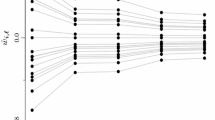Abstract
Because of limitations of the univariate frailty model in analysis of multivariate survival data, a bivariate frailty model is introduced for the analysis of bivariate survival data. This provides tremendous flexibility especially in allowing negative associations between subjects within the same cluster. The approach involves incorporating into the model two possibly correlated frailties for each cluster. The bivariate lognormal distribution is used as the frailty distribution. The model is then generalized to multivariate survival data with two distinguished groups and also to alternating process data. A modified EM algorithm is developed with no requirement of specification of the baseline hazards. The estimators are generalized maximum likelihood estimators with subject-specific interpretation. The model is applied to a mental health study on evaluation of health policy effects for inpatient psychiatric care.
Similar content being viewed by others
References
O. O. Aalen, “Mixing distributions on a Markov Chain,” Scand. J. Statist vol. 14 pp. 281–289, 1987.
J. E. Anderson and T. A. Louis, “Producing negative associations in random effect survival models,” ENAR Conference, 1994.
K. J. Bandeen-Roche and K.-Y. Liang, “Modeling failure-time associations in data with multiple levels of clustering,” Technical Report # p778, Johns Hopkins University Department of Biostatistics, Baltimore, Maryland, 1995.
D. G. Clayton, “A model for association in bivariate life-tables and its application in epidemiological studies of familiar tendency in chronic disease incidence,” Biometrika vol. 65 pp. 141–151, 1978.
D. G. Clayton and J. Cuzick, “Multivariate generalization of the proportional hazards model (with discussion),” Journal of the Royal Statistical Society, Series A pp. 82–117, 1985.
C. Elbers and G. Ridder, “True and spurious duration dependence: The identifiability of the proportional hazard model,” Review of Economics Studies vol. XLIX pp. 403–409, 1982.
C.J. Flinn and J.J. Heckman, “Models for the analysis of labor force dynamics,” Adv. Econometr. vol. 1 pp. 35–95, 1982.
R. G. Frank and R. Brookmeyer, “Managed mental health care and patterns of inpatient utilization for treatment of active disorders,” Social and Psychiatric Epidemiology vol. 30 pp. 220–223, 1995.
J. J. Heckman and J. R. Walker, “The relationship between wages and income and the timing and spacing of births: evidence from Swedish longitudinal data,” Econometrica vol. 58 pp. 1411–1441, 1990.
P. Hougaard, “Survival models for heterogeneous population derived from stable distributions,” Biometrika vol. 73 no. 2 pp. 387–396, 1986a.
P. Hougaard, “A class of multivariate failure time distribution,” Biometrika vol. 73 pp. 671–673, 1986b.
H. Joe, “Parametric families of multivariate distributions with given margins,” Journal of Multivariate Analysis vol. 46 pp. 262–282, 1993.
S. Johansen, “An extension of Cox's regression model,” International Statistical Review vol. 51 pp. 258–262, 1983.
N. L. Johnson and S. Kotz, Distributions in Statistics, Continuous Multivariate Distributions vol. 3. New York: Wiley, 1972.
P. J. Klein, “Semiparametric estimation of random effects using the Cox model based on the EM algorithm,” Biometrics vol. 48 pp. 795–806, 1992.
M. Lindeboom and G. J.Van Den Berg, “Heterogeneity in models for bivariate survival: the importance of the mixing distribution,” Journal of the Royal Statistical Society, Series B vol. 56 pp. 49–60, 1994.
A. W. Marshall and I. Olkin, “Families of multivariate distribution,” Journal of American Statistical Association vol. 83 pp. 834–841, 1988.
S. Murphy, “Asymptotic theory for the frailty model,” Technical Report 108, Department of Statistics, Pennsylvania State University, 1992.
S. Murphy, “Consistency in a proportional hazards model incorporating a random effect,” The Annals of Statistics vol. 22 no. 2 pp. 712–731, 1994.
G. Nielsen, R. Gill, P. Anderson, T. Sorensen and I. Thorkild, “A counting process approach to maximum likelihood estimation in frailty models,” Scandinavian Journal of Statistics vol. 19 no. 1 pp. 25–44, 1992.
D. Oakes, “Use of frailty models for multivariate survival data,” Draft for Presentation at IBC, Hamilton, August, 1994.
D. Oakes, “Bivariate survival models induced by frailties,” Journal of the American Statistical Association vol. 84 pp. 487–493, 1989.
S. G. Self, “A regression model for counting process with a time dependent frailty,” Technical Report # 95–01, Fred Hutchinson Cancer Research Center Biostatistics Program, Seattle, Washington, 1995.
A. Yashin, J. Vaupel and I. Iachine I, “Correlated individual frailty: an advantageous approach to survival analysis of bivariate data,” Population Studies of Aging #7, Center for Health and Social Policy, Odense University, Denmark, 1993.
Author information
Authors and Affiliations
Rights and permissions
About this article
Cite this article
Xue, X., Brookmeyer, R. Bivariate frailty model for the analysis of multivariate survival time. Lifetime Data Anal 2, 277–289 (1996). https://doi.org/10.1007/BF00128978
Received:
Accepted:
Issue Date:
DOI: https://doi.org/10.1007/BF00128978




